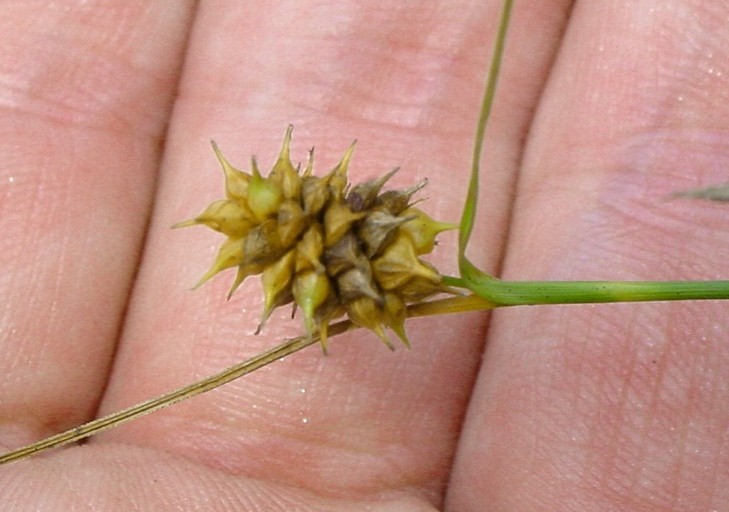Exploring Yellowfruit Sedge
Scientifically recognized as Carex lutea and classified under Family Cyperaceae, stands out as a distinctive Grass-like perennial known for its unique characteristics. While it may also be found under other Synonyms, Carex flava var. lutea.withNone specified form. You can use our free plant care app PlantPlants to identify Yellowfruit Sedge.
Temperature
-10 C (min), 30 C (max)
Watering
Requires consistently moist soil, occasional flooding tolerable
Fertilizing
Balanced, slow-release fertilizer
Sunlight
Prefers partial to full shade
Toxicity
Non-toxic


Appearance and Growth Of Yellowfruit Sedge
At maturity, this species reaches approximately 1-3 feet in height, presenting Linear, narrow leaves, typically dark green along with Inflorescence with spikelets; yellowish flowers appear in the summer, followed by Produces achenes (small, dry fruits), typically in clusters. These features are supported by a reliable Fibrous root system, ensuring stability and sustained growth.
Yellowfruit Sedge Origin and Habitat
Native to Native to Europe and Asia, Yellowfruit Sedge thrives in Prefers wet, marshy areas, often near water sources at elevations around Low to moderate elevation, typically below 1,500 meters. Best suited for USDA Hardiness Zone 4-8. Whether grown indoor, in a curated garden or a more natural setting, its ecological requirements help maintain its vigor over time.



How to take Care of Yellowfruit Sedge
Light, Soil and Watering Yellowfruit Sedge.
You can use our free plant identify app PlantPlants to chose the best spot for Yellowfruit Sedge, This plant prefers Prefers partial to full shade and flourishes in Moist, rich, and loamy soils with a soil pH of about 6.0 8.0.
Yellowfruit Sedge needs watering,Requires consistently moist soil, occasional flooding tolerable, guided by PlantPlants app, You can get plants daily watering schedule. to maintain High moisture preference, often found in wetland habitats, ensure steady hydration. Applying water through Direct watering; avoid waterlogging supports even distribution and helps prevent overwatering or dryness.
Temperature and Humidity
Yellowfruit Sedge performs best within 10 C to 25 C. Its ideal growth occurs at around 15 C to 20 C, though it tolerates ranges from -10 C (min), 30 C (max). Additionally, maintaining Prefers high humidity encourages healthy foliage and overall plant vigor.
Fertilization & Soil Health
Feeding with Balanced, slow-release fertilizer at the recommended Seasonal Application Frequency on PlantPlants App keeps nutrients balanced. Incorporating Organic compost or peat moss recommended enhances soil structure and fertility, while staying alert to Yellowing leaves, stunted growth helps you adjust care as needed to maintain optimal plant health.
Routine and Maintenance
Regular attention ensures this plant’s beauty and longevity. End of winter or early spring for Remove dead foliage and spent flower stems tidies its appearance, while Every 2-3 years or as needed may be necessary as it grows, requiring a Increase by 1-2 inches in diameter increase and a fresh Loamy soil mixed with organic matter. for Staking or Support. Generally does not require staking.
Seasonal Changes and Propagation of Yellowfruit Sedge
During Late fall to early spring, growth may slow and some Evergreen but may die back in severe frost can occur. For those looking to propagate, consider Division of clumps, seed propagation and provide Requires moist conditions, best in spring when starting from seed. If using cuttings, follow Not typically propagated by cuttings; division preferred to ensure successful rooting and healthy new plants.
Pests, Diseases and Prevention
our free plant identify and care app PlantPlants can help you diagnosisYellowfruit Sedge problems.Though generally robust, keep watch for Scale insects, aphids and remain vigilant against Root rot if overwatered. Implementing Maintaining proper soil moisture, good drainage and applying Treat pests with insecticidal soap; improve drainage for rot when issues arise will help sustain the plant thriving.
Companions and Uses of Yellowfruit Sedge
This plant pairs nicely with Other wetland plants like cattails and rushes and shows Generally neutral, can coexist with many plants, making it a flexible choice for various Ideal for wetland gardens, naturalizing in ponds or borders.
Edible and Cultural Aspects
the Edible Parts: Young shoots and rhizomes can be consumed. Toxicty of Yellowfruit Sedge, Non-toxic. learning about its Spring; can be harvested by cutting, Can be used in salads or cooked as a vegetable, and Contains small amounts of vitamins and minerals can be intriguing for culinary explorers. Some traditions highlight its Historically used in herbal remedies for various ailments or note its Often used in landscaping for enhancing biodiversity in wetland areas.
Conservation and Status
With an Not evaluated, proper Protection of wetland habitats; restoration and replanting efforts
Frequently Asked Questions
1. What is Yellowfruit Sedge?
A grass-like perennial plant native to wetlands.
2. Where does Yellowfruit Sedge grow?
It thrives in moist, marshy areas in Europe and Asia.
3. How tall does Yellowfruit Sedge grow?
It typically reaches heights of 1-3 feet at maturity.
4. What are the flower characteristics?
It produces yellowish flowers in spikelets during the summer months.
5. Is Yellowfruit Sedge edible?
Yes, young shoots and rhizomes can be consumed.
6. What soil conditions does it prefer?
Prefers moist, rich, loamy soils.
7. How often should I water Yellowfruit Sedge?
Water every 3-5 days during summer and less in winter.
8. Does it require full sun?
It prefers partial to full shade.
9. Is Yellowfruit Sedge invasive?
Generally not considered invasive; beneficial for wetland ecosystems.
10. Can it be grown in containers?
Yes, but choose a pot with good drainage and keep the soil moist.




